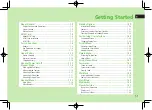
battery.
• Do not leave the battery in a cold (for example, a fridge) or hot place (for example, in
a car exposed to direct sunlight) as this will effect its performance.
• Do not dispose of the battery in a fire.
• Do not dispose of the battery in an ordinary bin. The battery contains toxic chemicals
and must be disposed of in the correct manner. Contact your local authority for more
information.
Emergency Calls
Calls cannot be made to emergency services while data communication is being
performed within a GSM area. If the system mode is set to UMTS Only or GSM Only,
calls cannot be made to emergency services if the selected network is unavailable.
Also, calls may not be able to be made to emergency services depending on the
network services of some service providers. You can still make calls to emergency
services when the SIM card is not inserted, the SIM card is locked, the phone lock is
set, Fixed Dialing Numbers is set, flight mode is set or call barring service is set.
However, there is no guarantee that a connection can be established in all countries
and areas because operation of your phone differs depending on the wireless network,
wireless signal and your phone’s setting status. Do not rely on just your mobile phone
when you need to make important calls such as calls to emergency services.
FCC RF Exposure Information
Your handset is a radio transmitter and receiver. It is designed and manufactured not
to exceed the emission limits for exposure to radio frequency (RF) energy set by the
Federal Communications Commission of the U.S. Government.
The guidelines are based on standards that were developed by independent scientific
organizations through periodic and thorough evaluation of scientific studies. The
standards include a substantial safety margin designed to assure the safety of all
persons, regardless of age and health.
The exposure standard for wireless handsets employs a unit of measurement known
as the Specific Absorption Rate, or SAR. The SAR limit set by the FCC is 1.6W/kg.
The tests are performed in positions and locations (e.g., at the ear and worn on the
body) as required by the FCC for each model. The highest SAR value for this model
handset when tested for use at the ear is 0.218 W/kg and when worn on the body, as
described in this user guide, is 1.439 W/kg. Body-worn Operation; This device was
tested for typical body worn operations with the back of the handset kept 1.5cm from
the body. To maintain compliance with FCC RF exposure requirements, use
accessories that maintain a 1.5cm separation distance between the user's body and
the back of the handset. The use of belt clips, holsters and similar accessories should
not contain metallic components in its assembly. The use of accessories that do not
satisfy these requirements may not comply with FCC RF exposure requirements, and
should be avoided.
The FCC has granted an Equipment Authorization for this model handset with all
reported SAR levels evaluated as in compliance with the FCC RF emission guidelines.
Содержание RG4-E01
Страница 1: ...TOSHIBA RG4 E01 User Manual Version 1 0 Copyright 2006 TOSHIBA CORPORATION All rights reserved ...
Страница 69: ...For example you may choose to synchronize details of your Calendar for the past two weeks only ...
Страница 92: ...Click this now and follow thru the steps in screenshots ...
Страница 93: ......



































